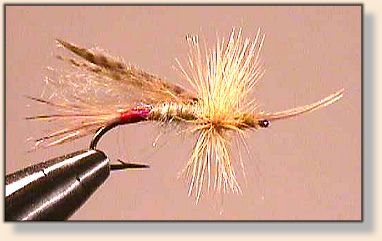
 Dizzy Blond By Thomas C. Duncan, Sr.
|
|
|
|
|
Tying Steps:
1. Tie in antennae facing forward over eye.
 2. Tie in light Elk hair tail directly over barb. Tail should be short, approximately the length of the hook gape. Tie on red silk for the butt, and wind it forward to just above the point. Silk is used because it retains the red colour better than Rayon and the other flosses. Any floss or thread can be used, though, with minimal difference in on-the-water performance.
 3. Dub the body with yellow dubb. I prefer Antron for this fly because of its sheen, but you can use any sort of fuzz you like. The body should be thin, and extend two-thirds of the way up the shank.
 4. Tie an underwing of Cul de Canard. It should extend to the length of the tail. Tie the Mallard flank above it exactly the same length. Both should be sparse. It is my opinion that dyed Mallard is better than natural Wood Duck in this one case because of the more vague markings. However, many people like the look of the natural better, and would rather use it.
 5. Tie in two ginger hackles. The shade should be quite light -- this shade is "Light Honey" from Ewing Featherbirds, and is perfect for the colouration of the natural. Wind the hackles, but leave enough room for the head, especially with the biots there.
Fishing Suggestions:
Editors Note:
|
[ HOME ]
[ Search ] [ Contact FAOL ] [ Media Kit ]